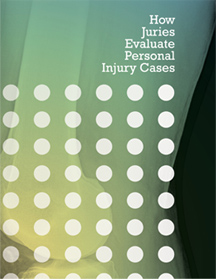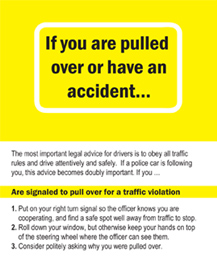Checklist of your deposition testimony
The following deposition checklist for bodily injury is written to be used for defense counsel’s cross-examination at a deposition. This checklist is structured on the basis of a defense attorney deposing the injured party regarding his or her injuries. This specific form is not designed for plaintiff’s counsel to use in deposing, or for trial testimony of, the plaintiff’s own treating doctor.
However, a plaintiff can use this checklist to prepare for his or her deposition. Asking yourself the questions on this checklist, then critiquing the answers with your attorney, will help you verbalize more adequately your bodily and mental problems when defense counsel asks questions on those subjects at your deposition.
Deposition Checklist
1. PERSONAL BACKGROUND
Get sufficient detail so that you can always have an investigator find this person for surveillance or do a records search regarding this person. If you are likely to have an investigator take surveillance photos, make notes on physical description of height, weight, color of hair, or anything else that will let an investigator identify which of four people in a group coming out of a house would probably be this person.
- All names ever used.
- Present and past residences for 10 years:
- If plaintiff has rented a residence, get name and address of landlord.
- Social security number.
- Complete marital history:
- If there is a previous marriage, get information sufficient to locate the past spouse. Usually a divorced spouse is quick to tell you the flaws of character or adverse facts of the ex-spouse.
- Military history:
- When?
- Where?
- Rank and military occupation.
- Military serial number.
- What type of discharge.
- If there is military history, ask whether ever hospitalized in the military (and when, where, and what for). If dishonorably discharged, get all information you can, in the hope of obtaining records of charges.
For any medical insurance coverage:
- Medical provider(s) paid by insurer.
- Name(s) and address(es) of medical insurer(s):
- ID number(s).
- Medical insurer(s) having any lien(s) in this case.
- Obtain and photocopy ID card(s).
- Has plaintiff ever:
- Made claim for personal injury?
- Been party to lawsuit?
- Received disability benefits?
- Applied for life or accident insurance since accident?
- Applied for worker’s compensation or received it?
- Applied for unemployment compensation or received it?
- Been convicted of any criminal offense?
- Birth date.
- School and education history.
- Complete history regarding children:
- Name(s).
- Age(s).
- Living in plaintiff’s home.
- Address(es).
2. REMEDIAL INFORMATION
- Employment before accident:
- When?
- Position and duties.
- Wages received.
- When quit and why?
- Employment at injury date and since then:
- Employer name and city.
- Position and duties.
- Exactly what physical work is done.
- Any change in work or position since accident.
- Any time lost from work.
- Is loss of income claimed?
- Whatever the answer to the above, also ask:
- Has your income gone up or down since being injured?
- Explain movements of income up or down.
- Who prepares your income tax returns?
- Obtain copies of tax returns.
- If plaintiff was still in school when injured:
- Loss of time.
- Athletics, dancing and social activities.
- Special damages:
- Medical and hospital.
- Services rendered by others.
- Property damage.
- Anything else not covered.
3. MEDICAL HISTORY
- Bodily defects before accident:
- Last exam before accident.
- Family doctor.
- Any disability.
- Condition of each area of body injured in the incident.
- Previous incidents causing injuries, with medical treatment:
- When and circumstances.
- Injuries and recovery.
- Doctors and hospitals.
- Suit or claim.
- Previous serious sickness or disease before incident:
- What?
- When?
- Where?
- Who involved?
- Treating doctors.
- Injuries and recoveries.
- Any other incident or injury after the incident in question?
- What?
- When?
- Where?
- Who involved?
- Treating doctors.
- Injuries and recoveries.
- Any other sickness or disease after the incident?
- What?
- When?
- Where?
- Who involved?
- Treating doctors.
- Effect of sickness and recovery.
4. THE INCIDENT
- When plaintiff left the scene:
- How?
- With whom?
- Plaintiff’s injuries:
- Description of force and where applied.
- List each injury received.
- Eliminate portions of body not injured.
- Ask: “Are those all of the injuries you received from this incident?”
- Objective evidence of each listed injury.
- Subjective complaints.
- Ask: “What problems did you have from [each listed injury]?”
- General description of the recovery from the incident now in litigation:
- Affirm the previous list of injuries.
- Repeat the list of each part of body injured.
- Recovery from each injury.
- Present complaints and disabilities.
5. TREATMENT AFTER INCIDENT
- You will be getting medical records from most or all of the medical providers. The purpose here is not to get exact dates and facts shown in the medical records but to get the plaintiff’s version of what the injuries are; how the plaintiff will present the injuries at trial; and any testimony that could minimize the injuries (for later use by you at trial).
- First doctor:
- Who suggested seeing this doctor?
- All first-visit complaints made to this doctor.
- Treatment given or prescribed by this doctor on first visit.
- All complaints made to this doctor on later visit(s).
- Treatment given or prescribed by this doctor on later visit(s).
- Each other doctor:
- When first seen?
- Who suggested seeing this doctor?
- All first-visit complaints made to this doctor.
- Treatment given or prescribed by this doctor on first visit.
- Treatment given or prescribed by this doctor on later visit(s).
- ER or urgent care treatment.
- First hospital admission:
- When admitted?
- What done in hospital?
- Condition on discharge.
- Each later hospitalization:
- When admitted?
- What done in hospital?
- Condition on discharge.
- Casts, bandages, technical aids for sleep or to avoid pain, or other appliances.
- Ever confined to bed or home:
- When?
- How long?
- Why?
6. ACTIVITIES BEFORE INJURY
- Vehicle activities:
- Drive own vehicle.
- Maintain or repair vehicles in the household.
- Home activities:
- Cooking.
- Sweeping and dusting.
- Making beds.
- Laundry.
- Shopping.
- Outdoor landscaping or gardening.
- Building repairs.
- Social activities:
- Dancing.
- Clubs.
- Attending dinners or luncheons.
- Church activities.
- Sports activities:
- Play.
- Watch other than by TV.
- Vacation and trip activities:
- To where?
- What?
- When?
- Activities during the trip or vacation.
7. ACTIVITIES SINCE INJURY
- Vehicle activities:
- Drive own vehicle.
- Maintain or repair vehicles in the household.
- Home activities:
- Cooking.
- Sweeping and dusting.
- Making beds.
- Laundry.
- Shopping.
- Outdoor landscaping or gardening.
- Building repairs.
- Social activities:
- Dancing.
- Clubs.
- Attending dinners or luncheons.
- Church activities.
- Sports activities:
- Play.
- Watch other than by TV.
- Vacation and trip activities:
- To where?
- What?
- When?
- Activities during the trip or vacation.



